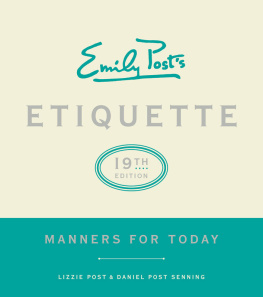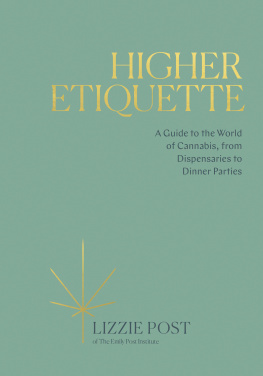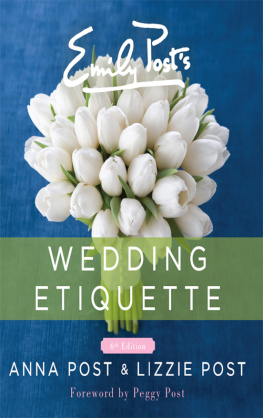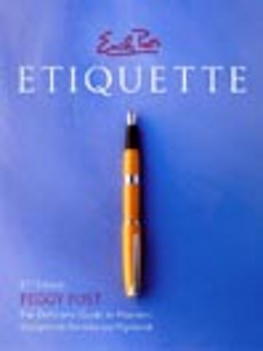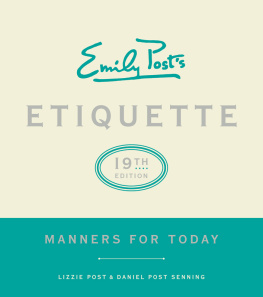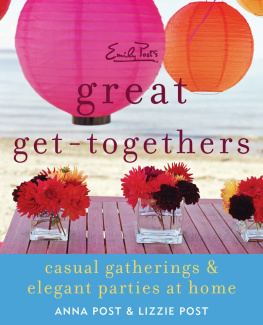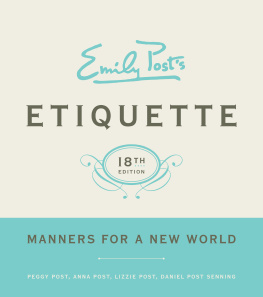Lizzie Post - Emily Post’s Etiquette
Here you can read online Lizzie Post - Emily Post’s Etiquette full text of the book (entire story) in english for free. Download pdf and epub, get meaning, cover and reviews about this ebook. year: 0, genre: History. Description of the work, (preface) as well as reviews are available. Best literature library LitArk.com created for fans of good reading and offers a wide selection of genres:
Romance novel
Science fiction
Adventure
Detective
Science
History
Home and family
Prose
Art
Politics
Computer
Non-fiction
Religion
Business
Children
Humor
Choose a favorite category and find really read worthwhile books. Enjoy immersion in the world of imagination, feel the emotions of the characters or learn something new for yourself, make an fascinating discovery.
- Book:Emily Post’s Etiquette
- Author:
- Genre:
- Year:0
- Rating:5 / 5
- Favourites:Add to favourites
- Your mark:
- 100
- 1
- 2
- 3
- 4
- 5
Emily Post’s Etiquette: summary, description and annotation
We offer to read an annotation, description, summary or preface (depends on what the author of the book "Emily Post’s Etiquette" wrote himself). If you haven't found the necessary information about the book — write in the comments, we will try to find it.
Lizzie Post: author's other books
Who wrote Emily Post’s Etiquette? Find out the surname, the name of the author of the book and a list of all author's works by series.
Emily Post’s Etiquette — read online for free the complete book (whole text) full work
Below is the text of the book, divided by pages. System saving the place of the last page read, allows you to conveniently read the book "Emily Post’s Etiquette" online for free, without having to search again every time where you left off. Put a bookmark, and you can go to the page where you finished reading at any time.
Font size:
Interval:
Bookmark:

With love, gratitude, and great respect we dedicate the 19th edition to the fourth generation of the Post family: Allen, Bill, Cindy, and Peter. They have stewarded this tradition with such care and have made it possible for us to carry on the family legacy.
We also dedicate this book to Peggy Post and Anna Post, whose thoughtful, caring advice is reflected in the content of this book and whose years of dedication and service to Emily Post has been of great benefit to our family and our company.
contents


c reating this book was truly a team effort, and it is with gratitude and deep appreciation that we thank the following for their contributions:
Tricia Post, who has edited and shepherded the 19th edition of Emily Posts Etiquette for the past two years; and Peter Post for his insights, advice, and keen eye.
Peggy Post, for her expert guidance and contributions, without which this book would not have been possible. With her twenty-five years of experience managing the brand both on her own and throughout its expansion, Peggy kept Emily Post alive and relevant, and made it possible for us to carry on our family legacy.
Anna Post, who over the last nine years has made significant contributions to the modernization of Emily Post etiquette. Annas ability to see broadly the effect that our advice can have was invaluable in ensuring that Emily Post truly is for everyone.
Cindy Post Senning, for her patient guidance and for continuing to serve in an advisory capacity to The Emily Post Institute.
Steven Puettner and Susan Iverson at The Emily Post Institute, and Katherine Cowles, our agent, for their encouragement and moral support, as well as their creative ideas and assistance.
Our sincere thanks go to Emily Krump, our editor at William Morrow, who has a magical way of fine-tuning our massive tome to be accessible, relevant, and enjoyable. Thanks, also, to everyone at William Morrow who has supported and championed Emily Posts Etiquette in all its editions, including Liate Stehlik, Lynn Grady, Katherine Gordon, Andrea Rosen, Nyamekye Waliyaya, Andrea Molitor, Julia Meltzer, and Madeline Jaffe.
John Smallwood and Alexis Siroc of Smallwood & Stewart, whose elegant design continues to give the 19th edition a beautiful, easy-to-follow format, complemented by Janice Richters charming and whimsical illustrations. Their work brings the written word to life.
Etiquette covers so many topics, and we are lucky to be able to draw on many generous sources. Not only do we value them for their expertise, but we consider them examples of best practice as well: Dr. Parveen Ali; Matt Bushlow; Cherlynn Conetsco; Nicole Dulac; Kris Engstrom; Dr. Manohar Singh Grewal and Mr. Ravinder Singh Taneja; Alka Gupta; April Harris; Anna Hart; Craig Iverson; Mac Keyser; Virginia Keyser; Mike Hakim; Deborah Jarecki; Britta Johnson; Adrea Kofman; Dale Loeffler; Barbara McDonald; Katherine Meyers; Owen Milne; John Parker; Peter Phillips; Thomas Pierce; Mauricia Rollins; Cindy Post Senning, Ed.D.; Kerin E. Stackpole, Esq., SPHR; and Samantha Wendel, B.A., CSA, CMC.
As this book is very much a reflection of the manners of today, we would also like to recognize the invaluable contribution of everyone who has sent us such interesting and challenging questions, in particular to the Awesome Etiquette podcast audience, and those who have reached out to us via social media. We are so grateful that you are not only interested in how your behavior affects others, but also are willing to share your questions and comments with our larger audience. Together we are building a nicer world and for that, we thank you.

i n a world that is constantly evolving its comforting to know that how we interact with one another still matters, and it is both rooted in tradition yet flexible enough to keep up with a rapidly changing and culturally diverse world. We want Etiquette to speak to traditional etiquette fans as well as those new to Emily Poston the one hand reaffirming the values and manners of previous generations, while at the same time promoting the best practices of current society. We know that mannersthe particular ways in which we show respect and considerationchange over time. Long gone are the 1st edition chaperone and the 12th edition ashtrays at the dinner table; they have been replaced by topics that have relevance to the daily lives of most Americans today, such as managing social media and mobile devices, having confidence at work, and navigating life at home.
The 19th edition of Etiquette reflects the different worlds we inhabitour homes, communities, social circles, and workplaces. We examine the manners and considerations essential to building strong families, careers, friendships, and positive work environments. We cover all of lifes stagesfrom birth or adoption, childhood, and adolescence to college, work, marriage, family, retirement, illness, and death. Often-accessed practical information, such as forms of address and attire charts, is grouped together in a ready-reference resource guide.
In our fast-paced, stressed-out world, is etiquette still relevant? We say yes: Etiquette is very much a topic of national conversation. At The Emily Post Institute, its a rare day when were not fielding media interviews on topics such as whats appropriate political conversation, what to register for when you already have the basics, whether its okay to unfriend your ex but not his friends, guidelines for polite smartphone use, and how to handle dinner guests myriad dietary restrictions. Emily Post has expanded its range from books, print columns, and a website to include a social media presence on Facebook, Twitter, and Instagram, as well as business etiquette training, seminars, and e-learning courses. Nothing illustrates the continuing relevance of etiquette more than the interactions we experience through the Awesome Etiquette podcast, hosted by Lizzie Post and Daniel Post Senning. They enjoy having a direct connection to their audience through the podcast. You, our readers, are also an essential part of those conversations. Your questions, feedback, suggestions, and etiquette salutes have further helped us to identify What is American etiquette today? It is clear to us through these interactions and conversations that etiquette still matters to Americans today.
As much as etiquette is about weddings and table settings and forms of address, at its most essential its about relationships and communication. Knowing which fork to use will give you social confidence, but applying the principles of etiquetteconsideration, respect, and honestywill enhance every interaction. Its now not just possible but commonplace to connect with dozens, hundreds, even thousands of people at once through social networks, instant messaging, tweets, texts, and emails. Video calls have left the office and come home to the living room or out to the beach. This communications revolution offers so many beneficial opportunities, not just to connect offices and families, but to give each individual a voice. With this opportunity to voice our opinions and share our ideas comes the responsibility to do so civilly. Irresponsible rants and defamatory remarks are divisive and polarizing, and only serve to heighten anxiety and sow distrust. Used wisely, communication channels in all their forms can be powerful tools to build communities and foster civil discourse, cooperation, and positive outcomes. As our country faces the challenges of an increasingly complex and diverse world, civility becomes all the more critical to our success.
Font size:
Interval:
Bookmark:
Similar books «Emily Post’s Etiquette»
Look at similar books to Emily Post’s Etiquette. We have selected literature similar in name and meaning in the hope of providing readers with more options to find new, interesting, not yet read works.
Discussion, reviews of the book Emily Post’s Etiquette and just readers' own opinions. Leave your comments, write what you think about the work, its meaning or the main characters. Specify what exactly you liked and what you didn't like, and why you think so.

